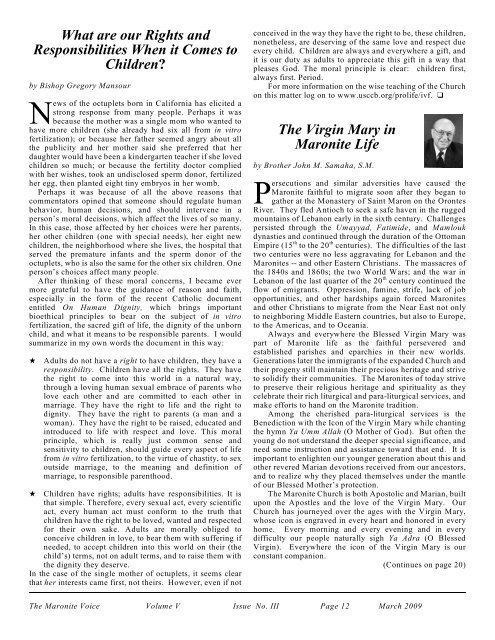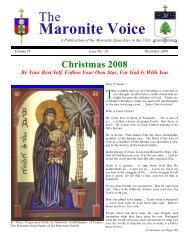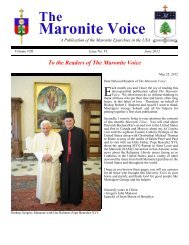Maronite Voice - Eparchy of Saint Maron of Brooklyn
Maronite Voice - Eparchy of Saint Maron of Brooklyn
Maronite Voice - Eparchy of Saint Maron of Brooklyn
You also want an ePaper? Increase the reach of your titles
YUMPU automatically turns print PDFs into web optimized ePapers that Google loves.
What are our Rights andResponsibilities When it Comes toChildren?by Bishop Gregory MansourNews <strong>of</strong> the octuplets born in California has elicited astrong response from many people. Perhaps it wasbecause the mother was a single mom who wanted tohave more children (she already had six all from in vitr<strong>of</strong>ertilization); or because her father seemed angry about allthe publicity and her mother said she preferred that herdaughter would have been a kindergarten teacher if she lovedchildren so much; or because the fertility doctor compliedwith her wishes, took an undisclosed sperm donor, fertilizedher egg, then planted eight tiny embryos in her womb.Perhaps it was because <strong>of</strong> all the above reasons thatcommentators opined that someone should regulate humanbehavior, human decisions, and should intervene in aperson’s moral decisions, which affect the lives <strong>of</strong> so many.In this case, those affected by her choices were her parents,her other children (one with special needs), her eight newchildren, the neighborhood where she lives, the hospital thatserved the premature infants and the sperm donor <strong>of</strong> theoctuplets, who is also the same for the other six children. Oneperson’s choices affect many people.After thinking <strong>of</strong> these moral concerns, I became evermore grateful to have the guidance <strong>of</strong> reason and faith,especially in the form <strong>of</strong> the recent Catholic documententitled On Human Dignity, which brings importantbioethical principles to bear on the subject <strong>of</strong> in vitr<strong>of</strong>ertilization, the sacred gift <strong>of</strong> life, the dignity <strong>of</strong> the unbornchild, and what it means to be responsible parents. I wouldsummarize in my own words the document in this way:Adults do not have a right to have children, they have aresponsibility. Children have all the rights. They havethe right to come into this world in a natural way,through a loving human sexual embrace <strong>of</strong> parents wholove each other and are committed to each other inmarriage. They have the right to life and the right todignity. They have the right to parents (a man and awoman). They have the right to be raised, educated andintroduced to life with respect and love. This moralprinciple, which is really just common sense andsensitivity to children, should guide every aspect <strong>of</strong> lifefrom in vitro fertilization, to the virtue <strong>of</strong> chastity, to sexoutside marriage, to the meaning and definition <strong>of</strong>marriage, to responsible parenthood. Children have rights; adults have responsibilities. It isthat simple. Therefore, every sexual act, every scientificact, every human act must conform to the truth thatchildren have the right to be loved, wanted and respectedfor their own sake. Adults are morally obliged toconceive children in love, to bear them with suffering ifneeded, to accept children into this world on their (thechild’s) terms, not on adult terms, and to raise them withthe dignity they deserve.In the case <strong>of</strong> the single mother <strong>of</strong> octuplets, it seems clearthat her interests came first, not theirs. However, even if notconceived in the way they have the right to be, these children,nonetheless, are deserving <strong>of</strong> the same love and respect dueevery child. Children are always and everywhere a gift, andit is our duty as adults to appreciate this gift in a way thatpleases God. The moral principle is clear: children first,always first. Period.For more information on the wise teaching <strong>of</strong> the Churchon this matter log on to www.usccb.org/prolife/ivf. The Virgin Mary in<strong><strong>Maron</strong>ite</strong> Lifeby Brother John M. Samaha, S.M.Persecutions and similar adversities have caused the<strong><strong>Maron</strong>ite</strong> faithful to migrate soon after they began togather at the Monastery <strong>of</strong> <strong>Saint</strong> <strong>Maron</strong> on the OrontesRiver. They fled Antioch to seek a safe haven in the ruggedmountains <strong>of</strong> Lebanon early in the sixth century. Challengespersisted through the Umayyad, Fatimide, and Mamloukdynasties and continued through the duration <strong>of</strong> the OttomanththEmpire (15 to the 20 centuries). The difficulties <strong>of</strong> the lasttwo centuries were no less aggravating for Lebanon and the<strong><strong>Maron</strong>ite</strong>s -- and other Eastern Christians. The massacres <strong>of</strong>the 1840s and 1860s; the two World Wars; and the war inthLebanon <strong>of</strong> the last quarter <strong>of</strong> the 20 century continued theflow <strong>of</strong> emigrants. Oppression, famine, strife, lack <strong>of</strong> jobopportunities, and other hardships again forced <strong><strong>Maron</strong>ite</strong>sand other Christians to migrate from the Near East not onlyto neighboring Middle Eastern countries, but also to Europe,to the Americas, and to Oceania.Always and everywhere the Blessed Virgin Mary waspart <strong>of</strong> <strong><strong>Maron</strong>ite</strong> life as the faithful persevered andestablished parishes and eparchies in their new worlds.Generations later the immigrants <strong>of</strong> the expanded Church andtheir progeny still maintain their precious heritage and striveto solidify their communities. The <strong><strong>Maron</strong>ite</strong>s <strong>of</strong> today striveto preserve their religious heritage and spirituality as theycelebrate their rich liturgical and para-liturgical services, andmake efforts to hand on the <strong><strong>Maron</strong>ite</strong> tradition.Among the cherished para-liturgical services is theBenediction with the Icon <strong>of</strong> the Virgin Mary while chantingthe hymn Ya Umm Allah (O Mother <strong>of</strong> God). But <strong>of</strong>ten theyoung do not understand the deeper special significance, andneed some instruction and assistance toward that end. It isimportant to enlighten our younger generation about this andother revered Marian devotions received from our ancestors,and to realize why they placed themselves under the mantle<strong>of</strong> our Blessed Mother’s protection.The <strong><strong>Maron</strong>ite</strong> Church is both Apostolic and Marian, builtupon the Apostles and the love <strong>of</strong> the Virgin Mary. OurChurch has journeyed over the ages with the Virgin Mary,whose icon is engraved in every heart and honored in everyhome. Every morning and every evening and in everydifficulty our people naturally sigh Ya Adra (O BlessedVirgin). Everywhere the icon <strong>of</strong> the Virgin Mary is ourconstant companion.(Continues on page 20)The <strong><strong>Maron</strong>ite</strong> <strong>Voice</strong> Volume V Issue No. III Page 12 March 2009
















